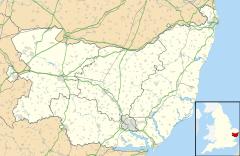Burstall facts for kids
Quick facts for kids Burstall |
|
|---|---|
 St Mary's, Burstall |
|
| Population | 189 (2001) |
| OS grid reference | TM0944 |
| District | |
| Shire county | |
| Region | |
| Country | England |
| Sovereign state | United Kingdom |
| Post town | Ipswich |
| Postcode district | IP8 |
| Dialling code | 01473 |
| EU Parliament | East of England |
Burstall is a small village and civil parish in Suffolk, England. It's located about 4 miles (6.4 km) west of Ipswich. This charming village is part of the Babergh district.
Burstall was first mentioned in the famous Domesday Book. This historical record was created in 1086. The village was known as Burgestala or Burghestala back then. Burstall is also part of the Belstead Brook electoral area. This area helps choose representatives for the Suffolk County Council.
The Belstead Brook forms the south-western edge of the parish. This brook is a small river that flows into the River Orwell. The A1071 road, which connects Ipswich and Hadleigh, crosses Belstead Brook at Burstall Bridge.
Village Life and Landmarks
Burstall is home to a few interesting places. You can find Burstall Hall about two-thirds of a mile (1 km) northeast of the village center. There are also farms nearby, like Mill Farm to the west and Hill Farm to the east.
Burstall Village Hall
The village hall is a special place for the community. It was built in 1910 to honor John Cranfield. The building has a unique Mock Tudor style. This means it looks like old Tudor-era buildings. The hall has also received money from a lottery grant for improvements. It's a great spot for local events and gatherings.
In the past, Burstall had a pub called The Half Moon. It closed its doors in 1968. The village's Post Office also closed in 2006.
St Mary's Church
The parish church of St Mary is a very old and important building in Burstall. It has been recognized as a Grade I listed building since February 22, 1955. This means it's a building of exceptional historical interest.
The church was mostly built in the early 1300s and 1400s. It has been carefully repaired and updated over the years. Major restoration work happened in 1866. More improvements were made between 1870 and 1873. These later repairs were done by Frederick Barnes, an architect from Ipswich.


